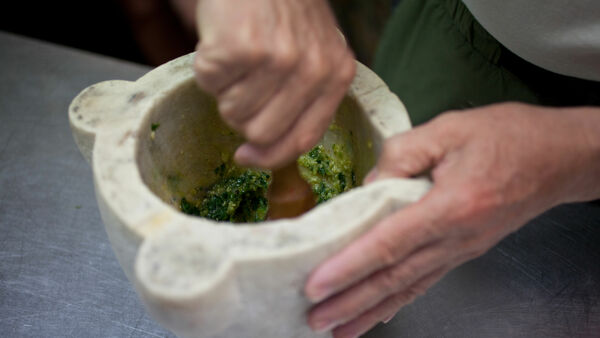Pesto alla Genovese (Ligurian pasta with pesto sauce)

Liguria — home to the Italian Riviera — is the birthplace of pesto. Basil, which loves the temperate Ligurian climate, is pounded with grated Pecorino Romano cheese, garlic, olive oil, pine nuts, and coarse salt to create a creamy green sauce, which is then tossed with pasta.
Once upon a time, pesto was invariably made by hand using a mortar and pestle; in fact, the name implies the act of using the pestle. This is still the classic and preferred method, but these days, even much of the pesto consumed in Liguria is made in a blender. Handmade pesto is still better, because the ingredients have been worked less, but blender pesto is fine as long as you use the finest, freshest ingredients available.
Two distinctive Ligurian pastas are designed specifically for pesto to cling to: trenette (long, flat noodles similar to linguine) and trofie (short, dense twists). Otherwise, you can use spaghetti, maccheroni, or linguine. Pesto also goes wonderfully over gnocchi, or in a pesto lasagne — made with white sauce. If you’re making minestrone of another vegetable soup, you can also stir a tablespoon of pesto into each portion for an exquisite treat.
Ingredients for 4 Servings:
1 large bunch fresh basil leaves
4 cloves garlic, peeled
1 teaspoon (about 5 grams) pine nuts
3 ounces (about 1 deciliter) extra-virgin olive oil
¾ cup (about 100 grams) freshly grated Pecorino Romano
Salt to taste
Do not wash the basil. Simply wipe the leaves carefully with paper towels or a clean cloth to remove any dirt. Discard the stems.
Classic method: Place a few leaves of basil in a mortar. Add a clove of garlic and crush the leaves and garlic against the sides of the mortar using the pestle. Add a few more leaves of basil and another garlic clove, and repeat the process. Once you have crushed all of the basil and garlic, add the pine nuts. Crush until the basil, garlic, and pine nuts are well blended. Add a tablespoon of olive oil and combine with the ingredients in the mortar. Then add the Pecorino Romano a little at a time, stirring with a wooden spoon. Then stir in some more oil, a tablespoon at a time. Your goal is to have a thick, creamy sauce. (You may not need quite so much oil.)
Blender method: Place all of the ingredients in a blender and blend at high speed for 1 minute. Then lift the lid carefully and scrape the sides using a rubber spatula. Check the consistency of the pesto, which should be thick and creamy. Blend for a few more seconds if you think the pesto should be bit thinner, but don’t overdo it. A few cooks, after making blender pesto, add a touch of heavy cream, but this is not essential.
Some cooks add a bit of hot water from the pasta pot to dilute the pesto just before it’s tossed with the noodles.
Cook’s note: In Genoa, where pesto originated, a peeled and boiled potato is chopped into chunks and tossed with the pesto and pasta. The genovesi often add a few slivers of cooked string beans, as well.
Suggested wine: Pigato, Vermentino, or Venraccia di San Gimignano
(Recipe courtesy of Fred Plotkin, co-author of Rick Steves Italy for Food Lovers book.)

